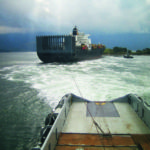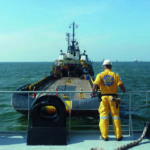Are the new US Coast Guard OPA 90 Salvage and Marine Firefighting regulations working, asks DeeAnn McMillen from T&T Bisso
While their enforcement only began on 22 February 2011, the new salvage and firefighting regulations have had a long and[ds_preview] tortuous journey. Tracing origins to 1989 when the »Exxon Valdez« went aground on Bligh Reef, the OPA 90 (Oil Pollution Act) gave us rules for tank vessels carrying oil as cargo. Fast forward to 1999 when the »New Carissa« disaster off the Oregon coast placed the spotlight on dry cargo vessels carrying large quantities of bunker fuel, and a similar act for nontank vessels was enacted under the Coast Guard Maritime Transportation Act of 2004. »Selendang Ayu« (2004) and »Cosco Busan« (2008) kept that spotlight focused on nontank vessels, and in 2009 the US Coast Guard (USCG) published draft regulations addressing that vessel species.
Now »Deepwater Horizon« (2010) has shown the incredible public and congressional frustration and ire that are likely to generate a new wave of reactive regulations which will probably affect our industry. The next catastrophic marine event with a less than stellar response may find a different cast of operators, regulators and responders, the new »regulars« on CNN.
The regulatory journey has been protracted by any standard as well as a tremendous challenge to both the USCG and marine industry. September 11 and the resultant federal emphasis on maritime security diverted USCG resources and slowed the process. Without success, the tanker industry strongly urged that the regulations for tank and nontank vessels be promulgated concurrently to »level the playing field«; however, at the moment one can only guess when the nontank regulation will be finalized.
The multifaceted and diverse business of salvage and firefighting has been reflected by the necessity for a relatively complex set of rules covering 19 different scenarios and services and 41 geographic areas. These regulations have been difficult for rule makers to draft and for the marine industry to sort out. Over the years, no fewer than five different USCG project officers have been assigned to manage the process. When you take into account the enormity of the US coast line and inland navigable waterways, you begin to realize that we indeed have a challenging set of regulations. Whether the crisis is caused by human error, act of nature, or terrorist attack, the ability to deploy the proper equipment and personnel to a marine casualty is paramount to environmental protection and homeland security.
So what are some of the positive byproducts of the OPA 90 Salvage and Marine Firefighting (SMFF) regulations? Foremost is the realization that if activated promptly, professional salvage services can prevent pollution and mitigate liability. As an example, during the past four years, T&T Bisso embarked into a well-orchestrated campaign to develop a solid casualty response system throughout the US. This system includes the largest inventory of salvage kit in the Americas with pre-staged specialized equipment at more than twenty major ports, a network of more than 1,450 towing vessels, and experienced salvage teams at the ready.
The system is routinely and regularly vetted by both clients and the USCG to ensure compliance. The investment has certainly paid off, placing T&T Bisso as the contractor of choice for more than 60 % of the tank vessel market, including most vessel-operating oil majors.
Under a pre-contracted arrangement, approved by the International Group of P&I Clubs and the USCG, these resources are ready to respond and assist shipowners in meeting the regulated planning response times. The system has already been put to the test several times and the results have been extremely positive allowing shipowners, oil majors, and underwriters to begin accepting the fact that preparedness pays off. It is not a matter of »if« but »when«, as the nontank salvage and marine firefighting regulations are coming to a COTP zone near you. Nontank owners should immediately start becoming familiar with the SMFF resources available in the US market. Name recognition alone does not ensure the adequacy of a SMFF provider in the US. A vessel owner should take an active role in choosing the salvor who is listed in their vessel response plan (VRP); after all it is the vessel owner who bears the sole responsibility under this aggressive regulatory scheme.
As the number of major tanker incidents in US waters continues to dwindle, one may argue that the regulations are working. The USCG certainly believes so and many of the owners who have had the opportunity to activate their VRP will tend to agree. However, it is important for vessel operators to always maintain vigilance and recognize that as long as humans are involved in shipping, major casualties can and will happen.
Author:
DeeAnn McMillen
Director of Vessel Services,
T&T Bisso LLC info@ttbisso.com,
www.ttbisso.com
DeeAnn McMillen




















